|
|
|
K |
|
Kidang Milar is a keris of a Dapur with 9 Luk. The shape is really very simple. The blade length is normal. The Gandik is simple, but there are Greneng. |

|
Kidang Soka is a Dapur of a keris with 7 or 9 Luk. The blade length is normal. This keris has Kembang Kacang, only one Lambe Gajah, Sraweyan and Greneng, but some even Ri Pandan. Krisses from this Dapur are popular because they can get well. |
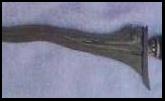
|
Kinatah or Tinatah is an adornment of a keris, Tombak, Pedang or other Tosan Aji. It is made of gold, hence the term kinatah Emas. Sometimes it is made of silver then it is called kinatah Perak. Is it mixed gold and silver it is called kinatah Silih Asih. There are various designs Lung Lungan as flowers, birds (Paksi Dewata), deer (Kidang Milar), lion, elephant, Arabic or Javanese letters etc. |
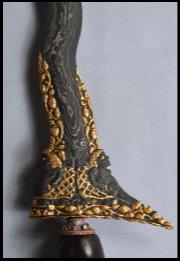

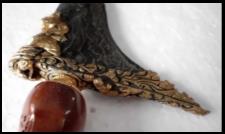
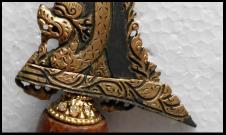
|
Ki Nom, Empu is a known Empu at the end of era of the Kingdom of Majapahit government Mataram Sultan Agung. |
|
Klabang Pipitan or also called Maraseba, is a carrying method of a keris in Yogyakarta. The gandar of the keris is worn behind the cloth belt approximately in the middle of the back. This carrying method is prescribed to employees of the Keraton for certain events. |

|
Klerek, Kanjeng Kyai is a Pusaka Tombak of the Kraton Yogyakarta from Dapur Bandotan with 9 Luk. |
|
Klikabenda or Kalika Benda is the Dapur of a keris with 9 Luk. The blade length is normal. He has a simple Gandik but it is 1 1/4 times as large as normal. This Dapur has Pejetan, Sraweyan, Ri Pandan, Greneng (often Greneng Sungsun). One calls the Dapur also Kala Bendu. |

|
Kocet-Kocetan is a form of a handle. The form looks like the larva of an animal, the "head" is similar to the head of a horse. Handles on Bali are called Daganan. There you will find these types of handles, which are very expensive and are often decorated with precious stones. |
|
Kodokan is the work of an Empu after iron, steel and pamor are "combined" . The Kodokan for krisses with Luk is larger than for straight krisses. |




|
Kodok, Empu is a known Empu from Madura, who lived at the end of Pajang Kingdom and beginning of Kingdom Mataram, therefore include his work both for Tangguh Pajang and for Tangguh Mataram. |
|
Kojongan is the form of a warangka on Bali or Lombok. This form is known in Java as Sandang Walikat. Often these warangka is decorated with gold or silver. Many Warangka Kojongan are made of Timoho Pelet wood. The length of a warangka Kojongan is 1.5 times as long as that of a warangka Sandang Walikat. |


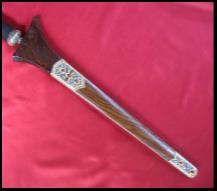
|
Kongbukongan is the form of a warangka in Madura and one of the new creations. It resembles the warangka Sandang Walikat called on Madura Jurigan. It stylizes the shape of a rose breast parakeet. In Madura the sheath and the handle are made by one person and therefore the handle also has this shape. |
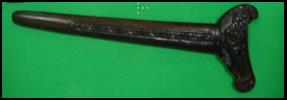
|
Kopek, Kanjeng Kyai Ageng is a Pusaka Keris from the Keraton of the Sultan of Yogyakarta. It was created by Empu Supo Anom at the time of the Government of Sultan Agung Anyokrokusomo. It comes from the dapur Jalak Sangu Tumpeng and has pamor Wos Wutah. The warangka is in fragrant sandalwood and the pendok is a pendok blewahan. |
|
Koripan, Tangguh is a Tangguh, but not Tangguh Kauripan. Koripan is a village about 20 km from Surakarta. At the time of the Government of Paku Buwono III. Empu Kyai Korip live in the village and his work was then called Tangguh Koripan. But the people of Surakarta assign them to the Tangguh Surakarta. |
|
Krawangan, Keris is a form of a keris with a blade which is provided with a perforated decoration. Keris experts in Surakarta and Yogykarta do not like this form. In East Java, Madura and Brunei there are many lovers of Keris Krawangan and there they are often decorated with gold. |

|
Krawangan, Ukiran is a form of a handle, which has a perforated ornament in the field of Cecekan. Making a Krawangan it is very difficult, since it must be symmetrical. Handles with Krawangan are therefore more expensive than normal handles. |


|
Kruwingan or Plunturan appears on the surface of the blade, and usually has two grooves. It lies between the blade edge and in front of the Ada-Ada, and then again between Ada-Ada and blade edge (see diagram left). The lengths are different, but they can go almost to the blade tip are often shorter. A Keris without Kruwingan have Sraweyan. Only in Dapur Mengantara lead two Kruwingan (A + B) up to half of the blade, and then as a Kruwingan (C) until the blade tip continued (see sketch). Kruwingan is also as a term for a part of a warangka Ladrang from Surakarta and is between Angkup and Awak-Awak or Dagingan, see parts of Warangka Ladrang. |


|
Kudi resembles in shape very a Kujang, which is a traditional weapon especially in Java and Madura. There are many different forms. Kujang is the traditional weapon of Parahiyangan in West Java. Kudi includes Tombak with a short handle. The length of a Kudi is 65-180 cm. Some call Kudi as Dapur for Tombak. A Kudi is made of iron and steel with a pamor. Some Kudi from the Keraton are decorated with kinatah gold. |




|
Komodo Sapto Buwono, Kanjeng Kyai is a new Pusaka Keris owned by Rahadi Saptata Abra from Jakarta. |
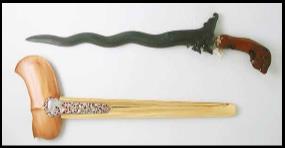
|
Kudung is a pamor that can be found only at the blade tip. It resembles the pamor Talak only it is aligned vice versa. |

|
Kikik is a Dapur of a keris with a dog figure. It is available with different Luk. |








|
Kraton means palace. There are famous kraton in Java, the Kraton in Yogyakarta and the Kraton in Surakarta (Solo). |